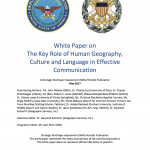Role of Human Geography, Culture and Language

The Key Role of Human Geography, Culture and Language in Effective Communication.
Author | Editor: Sutherlin, G. (Geographic Services, Inc.).
Overview
To begin with a truism, people in different places speak different languages; they belong to different cultures. This is not in dispute, but it remains a persistent operational challenge. Understanding other cultures well enough to successfully communicate and to navigate each information environment means a profound effort in putting ourselves in other cultures’ shoes—trying to understand narratives around identity, political engagement and deeply held beliefs requires looking beyond language and into the cognitive domain to gain a clearer picture of the information environment (IE).
Creating a clear picture for cognitive maneuver should not feel like charting a new frontier simply because the terrain is made up of unfamiliar cultural and linguistic objects. This white paper brings together several approaches from the academic and operational perspectives that describe cultural variation in communication patterns as well as the content of the communications– the complex concepts such as morality, loyalty and motivations– for the purpose of more effective cross-cultural communications analysis and engagement in the IE.
Human Geography, the study of relationships between locations, groups and individuals, provides a foundation for engaging in the cognitive domain, and in fact, in illustrating key aspects of the IE. Humans, after all, possess the cognitive aspects we want to understand. They produce the narratives, hold the beliefs and values, and are the audience targeted within the IE. Human Geography begins with location. Our origin is a significant part of who we are. Our home team that defines our allegiance. Our beliefs and behaviors which can be traced back to the history and events of that location. Perhaps it is the place we strive to protect, the site of an attack that prompts retaliation, the origin of our family name that gives us standing in the community, or the locus of our closest network with whom we share a dialect and a collective memory—our cultural narrative. If we understand culture as learned practices that set one group apart from another, part of that learning is connected to sharing a place. This is how British culture can be separate from American culture and yet still share the English language. Human Geography’s emphasis on location provides a foundation to understand culture, communication and cognitive maneuver.
The white paper is divided into three (3) sections that walk through a definition of the impact of cultural variation for operations in the IE; support for planning from theory, research and the field; and going forward for all USG engagements, several authors discuss approaches that hold promise from strategy to methodology. Authors share key insights on the state of the art in cultural narrative analysis and cognitive maneuver in the IE as well as theory, research and field observation that can support continued development of applied research, policy and training in this area.
Part One unfolds from the premise that most populations that the US Government engages with are bilingual or multilingual. Dr. Loyet writes that this is a contrast with the monolingual experience of many Americans. Multilingualism is one of many cultural differences we need to take into account for effective communications and analysis across the IE. Many populations are adept at shifting between languages for different purposes. From a cognitive perspective, the bi-lingual brain works differently with perception, memory and cognition. Shifting between linguistic identities is part of their daily lives. Dr. Spitaletta, bringing insights from a series of SMA papers on bio-psycho-social communication, writes that, “Cognitive processes such as perception, judgment, and decision- making are the most vital aspect of the IE.” Finally, Ms. Kompaniiets illustrates cultural narrative in action through a Ukrainian language use case.
Part Two steps back to explore theories on culture and communication that can support a sound approach to developing successful narratives and planning cognitive maneuver. Prof. Ess and Ms. MacNulty map out dimensions of culture and values that serve as building blocks for most working in this field. These are fundamental to grounding further practical research, operational methods or analytic products. Dr. Ehlschlaeger is already developing operational means to put theory into practice using human geography to help navigate communications challenges. As a field case in action, Ms. Mushtaq describes on-going efforts in the Khyber Pakhtunkwa and Federally Administrated Tribal Areas of Pakistan to identify and foster local forms of cultural narratives and communication that are seen to be effective for peacebuilding.
Part Three looks forward by focusing on current conflicts where communication, narrative and culture play a vital role in how we engage and how successful we are. This section brings together the operators’ view from Col (Ret.) Robert Jones, applied research on narratives of elite individuals, and a field interview with Mr. Maktary on peacebuilding in Yemen that describes successful and unsuccessful initiatives to influence the situation.
Finally, most authors have read across each other’s works and referenced one another in their papers. This experience has provided these expert contributors the chance to dialog on best practices, shared and conflicting viewpoints, gaps, strengths and ways forward. In this way, we are taking the chance to learn more on this topic ourselves while we contribute to the SMA white paper series.
Contributing Authors
Mr. John DeRosa (GMU), Dr. Charles Ess (University of Oslo), Dr. Charles Ehlschlaeger (USACE), Col (Ret.) Robert C. Jones (SOCOM), Olesia Kompaniiets (Polizor Centre) Dr. Dianne Loyet (University
of Illinois Springfield), Ms. Christine MacNulty (Applied Futures), Ms. Angie Mallory (Iowa State University), Mr. Shoqi Maktary (Search for Common Ground, Yemen), Ms. Yusra Mushtaq (Visiting Scholar, Pakistan), Dr. Amjed Rasheed (Durham University, Institute of Middle Eastern and Islamic Studies), Dr. Jason Spitaletta (JHU-APL, Maj, USMCR), Dr. Gwyneth Sutherlin (Geographic Services, Inc.)

Comments